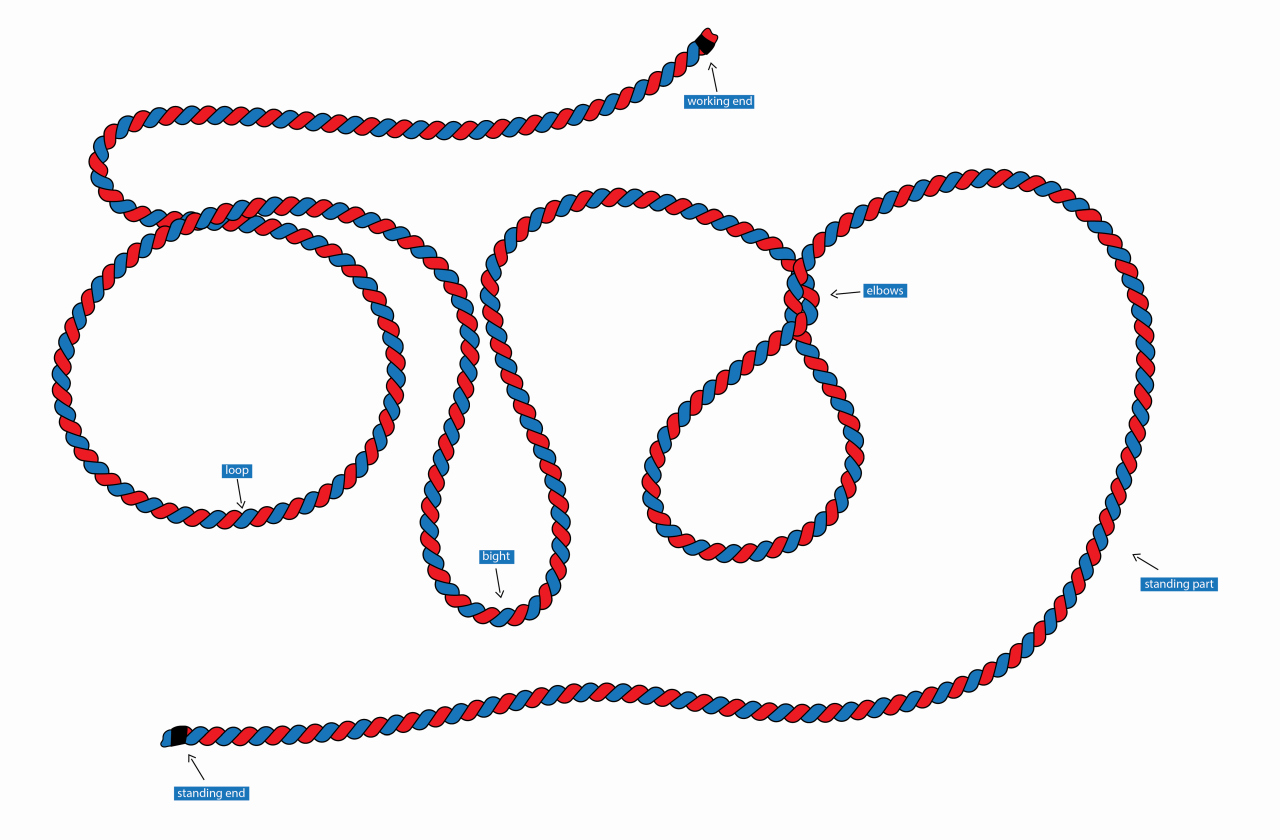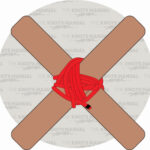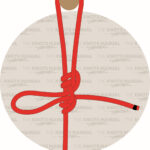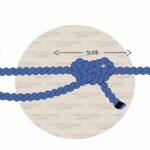The three main parts of a rope consist of the standing end, working end, and bight.
A rope is a strand that is more than 10 mm (3/12 in) in diameter, which is plaited, laid, or braided. Most strands smaller than that are “cords,” “string,” “thread,” or “twine.”

Important Rope & Knot Terminology
| Rope Terminology | Knot Terminology | Other Important Rope & Knot Terminology |
|---|---|---|
| Acquires | Bend | Capsizing |
| Bight | Binding knot | Chirality |
| Bitter end | Decorative knot | Dressing |
| Cordage or “stuff” | Ending knot | Dogging |
| Crossing point | Finishing knot | Kink |
| Elbow | Knots on the bight | Lashing |
| Eye | Friction hitch | Noose |
| Flake | Hitch | Open loop |
| Flaking | Jamming knot | Round turn |
| Fraps | Nip | Seizing |
| Line | Non-Jamming knot | Setting |
| Loop | Locking lock | Splice |
| Middle | Loop knot | Take a turn |
| Small stuff | Slipped knot | Tyer |
| Standing end | Stopper knot | |
| Turn | Whipping | |
| Working end |
17 Examples Of Rope Terminology
Acquires
Acquires are a specific type of line.
Examples include:
- Lanyard
- Lashing
- Lassoo
- Messenger
Bight
A bight is the central stretch of rope between the standing and working ends. A bight does not cross over itself.
It is also described as the arc in a rope within a knot being tied.
Bitter End
The working end of a rope.
Cordage or “Stuff”
Rope and cord collectively.
Crossing Point
A crossing point is where a rope crosses itself to make a loop.
Elbow
The elbow occurs when you make an extra twist in the rope’s loop, creating two or more loops close to each other.
Eye
An eye allows the rope to form connections without slipping. It is sometimes called a “loop,” but that is incorrect. The eye of a rope acts like an eye bolt or eye splice.
Flake
When you flake a rope, you are coiling it. A flake is the number of times you’ve coiled a rope.
Flaking
Flaking refers to laying a ready-to-use rope on a surface. It also refers to a rope running out without tangling.
Fraps
Fraps refers to several loops wrapped perpendicularly about a lashing. Fraps tighten the lashings.
Line
A line is a rope or cord dedicated to a specific job.
There are five kinds of lines:
- Tow line
- Washing line
- Lifeline
- Throwing line
- Heaving line
Loop
A loop is the most important structure of a rope used to create knots. You pass the rope’s working end over itself to create a full circle.
A loop that has “taken a turn” refers to the legs of a closed loop crossing to form a loop. In the end, this creates a closed circle in a line.
An Overhand Loop is a simple loop where the working end ties overtop the standing end.
An Underhand Loop is a loop whose working end goes underneath the standing part.
Middle
Creating a bight to determine the middle of the rope.
Small Stuff
Small stuff is another name for thin string or twine commonly used in nautical scenarios. Saliers often use “small stuff” for “whipping” to bind the ends of the rope, which prevents fraying.
Standing End
The standing end is the part of the rope not used to create a knot. It is the opposite of the “working end.”
Turn
A turn is one round of coiled rope. A Round Turn is when the rope completely encircles an object by wrapping around it twice. Two Round Turns are when the rope passes around an object three times.
Working End
The working end is the part of the rope you use to create a knot. It is the opposite of the “standing end.”
16 Examples Of Knot Terminology
Bend
A bend is a knot used to join two lengths of rope.
Binding Knot
A binding knot either holds two objects together or constricts a solitary object. The rope’s ends may join together or tuck under the knot’s turns.
Decorative Knot
Any kind of knot that is pleasing to the eye; it may be purely decorative or may serve a practical purpose. The creation of decorative knots is one of the oldest forms of folk art in the world. Decorative knots are widely distributed worldwide.
Knots On The Bight
Knots that you can tie without using the working end of the rope.
Friction Hitch
A friction hitch is a knot that attaches two ropes. The friction hitch attaches the ropes so that the knot is easily adjustable. Friction hitches are common in climbing and are sometimes called “slide-and-grip” knots.
Hitch
A hitch is a knot that allows a rope to attach to an object. A tied rope attaches to objects like posts, rails, rings, spars, and other types of ropes.
Jamming Knot
A knot that is difficult to untie.
Nip
A spot within the knot where the friction concentrates.
Non-Jamming Knot
A knot that is resistant to jamming.
Locking Tuck
A locking tuck secures the knot to keep it from unraveling or collapsing.
Loop Knot
A loop knot has a fixed “eye” that forms by “tying-in-the-bight” (TIB). This process only takes one step to make the eye knot.
Sometimes, “tying-in-the-bight” won’t work. For instance, they don’t work when attaching the knot to a climbing harness or tree. In these cases, creating the knot takes two steps. You make a “figure-8” knot and rethread the tail through and around the knot.
A loop knot differs from a hitch because it always maintains its shape. So, the “eye” retains its shape even if you remove it from an object and move it to another.
Slipped Knot
A slipped knot unties when you pull on the end of it.
Stopper Knot
A stopper knot prevents a rope from slipping through a grommet.
Whipping
A whipping is a binding knot that prevents the rope from unraveling. You tie a whipping around the end of a rope.
14 Other Rope & Knot Terms
Capsizing
Capsizing refers to a deformed knot that has become another structure. Capsizing is often an accident if a knot is used or tied incorrectly. You can capsize a knot on purpose to strengthen it. Intentional capsizing also serves to untie a seized knot. Seized knots are challenging to undo otherwise.
Chirality
Chirality refers to the handedness of a knot or how equal the left and right sides of the knot are.
Dressing
Dressing a knot refers to crossing or uncrossing a knot. Dressing a knot improves the strength and useability. Dressing a knot also decreases its potential for jamming.
Dogging
Dogging is turning a bight or loop into an “eye.” You create the eye by wrapping the rope’s end around the standing part several times.
Kink
A kink forms from pulling a loop so tightly that it deforms.
Lashing
A rope arranged to attach two or more objects, so they are rigid. Lashings are good for securing sailing masts or scaffolding poles.
There are three kinds of lashings:
- Square lashing: binds poles perpendicularly
- Diagonal lashing: binds poles diagonally
- Shear lashing: binds poles parallelly
Noose
A noose is a sliding loop that tightens when pulled.
Open Loop
An open loop is a rope that curves to form a semicircle where the legs do not touch or cross. The legs of an open loop come together to form a slimmer structure than they form in a bight.
Round Turn
A round turn refers to wrapping the working end more than necessary. The extra wrapping brings the working end alongside the standing end. Then, it is tied off.
Seizing
A knot that binds two pieces of rope together to form a loop. The two pieces of rope come together side by side.
Setting
Setting refers to tightening a knot.
Splice
Splicing is untwisting and re-weaving a rope’s strands to join two ropes together.
Take A Turn
“Take a turn” refers to checking a load and the amount of friction it creates.
Tyer
A person who ties knots.
FAQs
What Is Burning The End Of A Rope Called?
Burning the end of a rope is called “fusing” if you’re working with a rope made from synthetic fibers. Burning the end of a rope is called “whipping” if you’re working with a rope made from natural fibers. You will “fuse” or “whip” a rope when it becomes frayed and difficult to use. “Whipping” or “fusing” a rope makes the ends smooth again so the rope functions properly.
What Parts Of A Rope Do You Use To Tie A Knot?
The parts of a rope you will use to tie a knot include the working end and the bight. You will need to create loops, crossing points, elbows, and other tying methods to create your knot.




